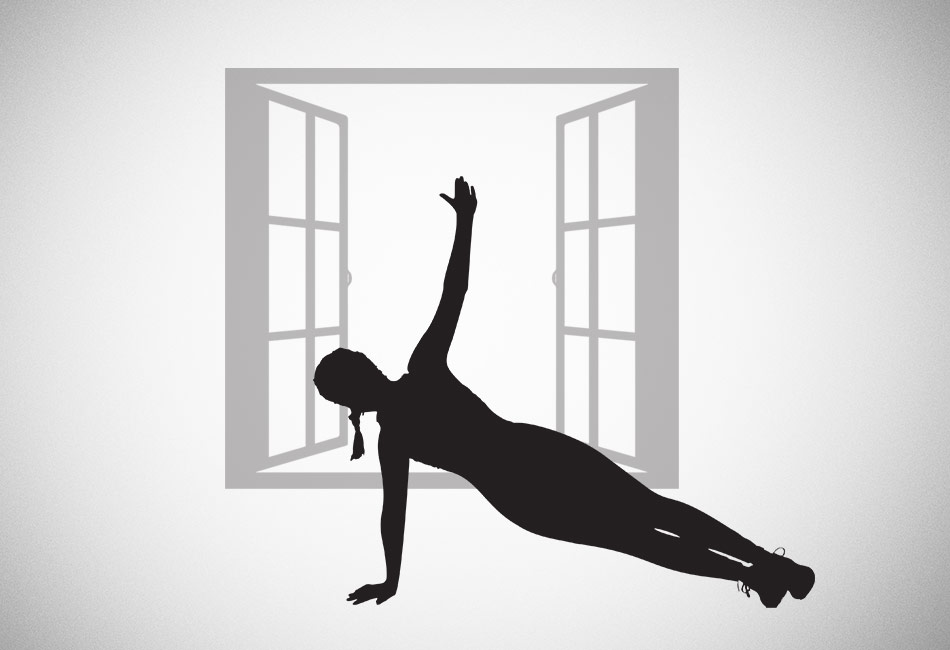We obviously believe that exercise is something that you can do on your own, any time, anywhere which is why we have a database of thousands of workouts of every level and category you can focus on and do at home. That doesn’t mean however that gyms are redundant or that a set of exercises is all you need in order to maintain your fitness.
For a start we understand that motivation is key to learning to exercise every day. A Centers for Disease Control (CDC) study[1] followed 32,000 individuals from both sexes and a variety of ages, over two years, and discovered that leisure time was no obstacle when it came to exercising. What is an obstacle to exercise however is the perception of physical discomfort involved when we start to exercise in the first instance.
Discomfort is an issue because, to a certain extent, it is necessary. Muscles get stronger and we get fitter when we apply a stressor that triggers the adaptive response we need for physical change to happen. But that is not the whole story. Low intensity training, over time, appears to deliver equally impressive results.[2]
The reason low-intensity exercise works is because, cumulatively, it represents a constant stressor which, in turn, activates the body’s adaptive response to strengthen muscles[3] and the body’s cardiovascular and aerobic systems much the same way as higher intensity exercise.
None of the obstacles already mentioned are the true reason we don’t normally choose to exercise from home. A 2015 study that focused on the psychological needs[4] that kept athletes in the gym found that intrinsic satisfaction, a sense of acceptance and a deeper sense of identity were better indicators for keeping them motivated over time than anything else. Psychologists call this self-determination theory[5] and point to its importance in establishing habits[6] that help us become better versions of ourselves.[7]
This also gives us the perfect recipe to apply to training from home when we can’t go to the gym.
Ten Steps To A Home-Based Fitness Regime
- Create a routine. Instead of trying to contort your day to fit some training in it, find a time that best fits your exercise routine and stick with it day after day. It only takes a few repetitions like that to make it part of your habitual daily routine[8] and you’ve got yourself a training plan that works for you.
- Start slow. Ambition is great as long as the initial plans that get you there are grounded in reality. Start with things you can do such as difficulty Level I Darebee workouts and build from there on a gradual basis.
- Make it interesting. Training alone, at home, can quickly become boring and boredom, even in small quantities, accumulates and kills your motivation.[9] Use role-playing game exercises or choose one of our role-playing fitness quests that also have a challenging storyline. Choose some linear ones such as, our latest, Zero Hero or go for more complicated storylines that involve an ending based upon your choices such as Age of Pandora.
- Get some support. In a traditional gym environment you have support from those around you, qualified gym instructors and trainers. Working at home, you’re usually alone. Questions you may have remain unanswered and as they build up they undermine your confidence which then impacts on your ability to continue with your home-based exercise. Join The Hive, Darebee’s super-friendly, social side and explore your fitness journey with thousands of people like you from all over the world. The company you keep plays a central role to how you behave when things get tough for you[10] and having people around you who can help lift your spirits and support you is crucial to maintaining your momentum.
- Keep yourself accountable. When we train on our own it becomes really easy to forget where we're at. This is where keeping good records of our workouts can help us reach our targets faster. A 2006 study of the effects of journal keeping on motivation and critical thinking showed that decision making improves[11] if we keep our self accountable by maintaining good records of our progress.
- Mix it up. Variety is not just the spice of life, it is also key to helping you maintain your fitness goals. Darebee has thousands of workouts, Challenges and Daily Dares to help you from growing stale in what you do. Having the option to change the exercises you do, as you wish helps you maintain your motivation[12, 13] and also, stops your body from habituating to exercises which means your physical progress is also better and faster.[14]
- Take photos. When we exercise progress is incremental. Because it happens slowly, day after day, it often becomes hard for us to notice the changes that occur. This is why pictures are so important. By ‘freezing’ our physical state each day they become an irrefutable record of our progress. It also helps our mental health[15].
- Set goals. Goal setting, literally, changes the way the brain works in ways that help us achieve those goals.[16] Provided that goal-setting is realistic, achievable and provides a solid sense of progression that feeds on motivation, the setting of goals is part of the personal strategies employed to maintain focus when working out alone.
- Challenge yourself. Small physical or mental challenges, repeated often, help our brain deal with the strain of change and the challenge of training alone. They also and go a long way towards developing grit and resilience.[17]
- Help others. Find ways to help others train also, either by using technology to connect with them or finding other ways that will also help them find ways to maintain their fitness. Helping others, either through encouragement and advice or through explanations and practical mentoring helps us develop a better-balanced inner world[18] with greater capacity for emotional regulation. In other words, through the process of helping others get fit and grow emotionally and psychologically we also help ourselves do the same.
Summary
You don’t have to implement all ten steps to successfully train at home. But if you do, you will find that your home-training experience is far from being a lonely one and, arguably, much more rewarding than just going to the gym. Most important of all, you will find yourself developing mental, emotional and psychological resources you just didn’t think you had.
Sources
- Sturm R, Cohen DA. Free Time and Physical Activity Among Americans 15 Years or Older: Cross-Sectional Analysis of the American Time Use Survey. Prev Chronic Dis 2019;16:190017.
- Tanaka H, Shindo M. The benefits of the low intensity training. Ann Physiol Anthropol. 1992 May;11(3):365-8. Review. PubMed PMID: 1642737.
- Liu F, Morris M, Hicklen L, Izadi H, Dawes H (2018) The impact of high and low-intensity exercise in adolescents with movement impairment. PLOS ONE 13(4): e0195944.
- Benjamin A. Sibley & Shawn M. Bergman (2018) What keeps athletes in the gym? Goals, psychological needs, and motivation of CrossFit™ participants, International Journal of Sport and Exercise Psychology, 16:5, 555-574, DOI: 10.1080/1612197X.2017.1280835.
- Teixeira, P.J., Carraça, E.V., Markland, D. et al. Exercise, physical activity, and self-determination theory: A systematic review. Int J Behav Nutr Phys Act 9, 78 (2012).
- Ednie, A., & Stibor, M. (2017). Influence and interpretation of intrinsic and extrinsic exercise motives. Journal of Human Sport and Exercise, 12(2), 414-425. doi:10.14198/jhse.2017.122.18.
- Oman, Roy & Mcauley, Edward. (1993). Intrinsic Motivation and Exercise Behavior. Journal of Health Education. 24. 232-238. 10.1080/10556699.1993.10610052.
- Gardner B, Lally P, Wardle J. Making health habitual: the psychology of 'habit-formation' and general practice. Br J Gen Pract. 2012;62(605):664–666. doi:10.3399/bjgp12X659466.
- Tze, V.M.C., Daniels, L.M. & Klassen, R.M. Evaluating the Relationship Between Boredom and Academic Outcomes: A Meta-Analysis. Educ Psychol Rev 28, 119–144 (2016).
- Cotton, Richard & Shen, Yan. (2013). The company you keep. Career Development International. 18. 328-356. 10.1108/CDI-09-2012-0093.
- Walker SE. Journal writing as a teaching technique to promote reflection. J Athl Train. 2006;41(2):216–221.
- Jordan Etkin and Rebecca K. Ratner, The Dynamic Impact of Variety among Means on Motivation. Journal of Consumer Research. The University of Chicago Press.
- Sylvester, Ben & Standage, Martyn & Ark, Tavinder & Sweet, Shane & Crocker, Peter & Zumbo, Bruno & Beauchamp, Mark. (2014). Is Variety a Spice of (an Active) Life?: Perceived Variety, Exercise Behavior, and the Mediating Role of Autonomous Motivation. Journal of Sport and Exercise Psychology. 36. 516-527. 10.1123/jsep.2014-0102.
- Cheung, Y.K., Moon, Y.P., Kulick, E.R. et al. Leisure-Time Physical Activity and Cardiovascular Mortality in an Elderly Population in Northern Manhattan: A Prospective Cohort Study. J GEN INTERN MED 32, 168–174 (2017).
- Brewster L, Cox AM. The daily digital practice as a form of self-care: Using photography for everyday well-being. Health (London). 2019 Nov;23(6):621-638. doi: 10.1177/1363459318769465. Epub 2018 Apr 7. PubMed PMID: 29627990; PubMed Central PMCID: PMC6745599.
- Berkman ET. The Neuroscience of Goals and Behavior Change. Consult Psychol J. 2018;70(1):28–44. doi:10.1037/cpb0000094
- Pickersgill M, Martin P, Cunningham-Burley S. The changing brain: Neuroscience and the enduring import of everyday experience. Public Underst Sci. 2015;24(7):878–892. doi:10.1177/0963662514521550
- Saulin A, Baumgartner T, Gianotti LRR, Hofmann W, Knoch D. Frequency of helping friends and helping strangers is explained by different neural signatures. Cogn Affect Behav Neurosci. 2019;19(1):177–186. doi:10.3758/s13415-018-00655-2.










